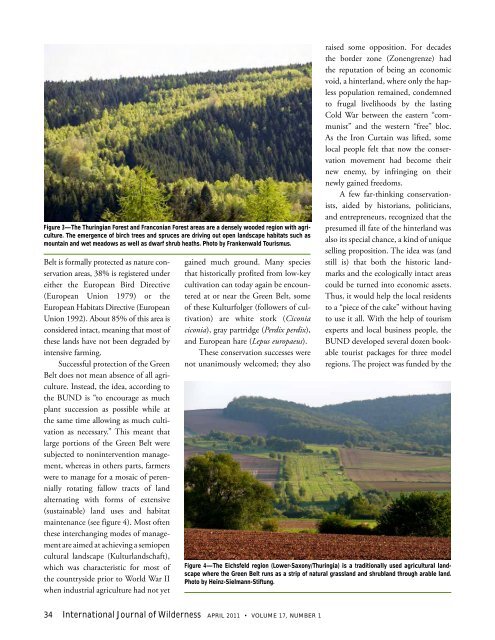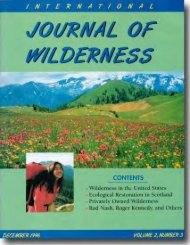Download April 2011 PDF - International Journal of Wilderness
Download April 2011 PDF - International Journal of Wilderness
Download April 2011 PDF - International Journal of Wilderness
You also want an ePaper? Increase the reach of your titles
YUMPU automatically turns print PDFs into web optimized ePapers that Google loves.
Figure 3—The Thuringian Forest and Franconian Forest areas are a densely wooded region with agriculture.<br />
The emergence <strong>of</strong> birch trees and spruces are driving out open landscape habitats such as<br />
mountain and wet meadows as well as dwarf shrub heaths. Photo by Frankenwald Tourismus.<br />
Belt is formally protected as nature conservation<br />
areas, 38% is registered under<br />
either the European Bird Directive<br />
(European Union 1979) or the<br />
European Habitats Directive (European<br />
Union 1992). About 85% <strong>of</strong> this area is<br />
considered intact, meaning that most <strong>of</strong><br />
these lands have not been degraded by<br />
intensive farming.<br />
Successful protection <strong>of</strong> the Green<br />
Belt does not mean absence <strong>of</strong> all agriculture.<br />
Instead, the idea, according to<br />
the BUND is “to encourage as much<br />
plant succession as possible while at<br />
the same time allowing as much cultivation<br />
as necessary.” This meant that<br />
large portions <strong>of</strong> the Green Belt were<br />
subjected to nonintervention management,<br />
whereas in others parts, farmers<br />
were to manage for a mosaic <strong>of</strong> perennially<br />
rotating fallow tracts <strong>of</strong> land<br />
alternating with forms <strong>of</strong> extensive<br />
(sustainable) land uses and habitat<br />
maintenance (see figure 4). Most <strong>of</strong>ten<br />
these interchanging modes <strong>of</strong> management<br />
are aimed at achieving a semiopen<br />
cultural landscape (Kulturlandschaft),<br />
which was characteristic for most <strong>of</strong><br />
the countryside prior to World War II<br />
when industrial agriculture had not yet<br />
gained much ground. Many species<br />
that historically pr<strong>of</strong>ited from low-key<br />
cultivation can today again be encountered<br />
at or near the Green Belt, some<br />
<strong>of</strong> these Kulturfolger (followers <strong>of</strong> cultivation)<br />
are white stork (Ciconia<br />
ciconia), gray partridge (Perdix perdix),<br />
and European hare (Lepus europaeus).<br />
These conservation successes were<br />
not unanimously welcomed; they also<br />
34 <strong>International</strong> <strong>Journal</strong> <strong>of</strong> <strong>Wilderness</strong> APRIL <strong>2011</strong> VOLUME 17, NUMBER 1<br />
raised some opposition. For decades<br />
the border zone (Zonengrenze) had<br />
the reputation <strong>of</strong> being an economic<br />
void, a hinterland, where only the hapless<br />
population remained, condemned<br />
to frugal livelihoods by the lasting<br />
Cold War between the eastern “communist”<br />
and the western “free” bloc.<br />
As the Iron Curtain was lifted, some<br />
local people felt that now the conservation<br />
movement had become their<br />
new enemy, by infringing on their<br />
newly gained freedoms.<br />
A few far-thinking conservationists,<br />
aided by historians, politicians,<br />
and entrepreneurs, recognized that the<br />
presumed ill fate <strong>of</strong> the hinterland was<br />
also its special chance, a kind <strong>of</strong> unique<br />
selling proposition. The idea was (and<br />
still is) that both the historic landmarks<br />
and the ecologically intact areas<br />
could be turned into economic assets.<br />
Thus, it would help the local residents<br />
to a “piece <strong>of</strong> the cake” without having<br />
to use it all. With the help <strong>of</strong> tourism<br />
experts and local business people, the<br />
BUND developed several dozen bookable<br />
tourist packages for three model<br />
regions. The project was funded by the<br />
Figure 4—The Eichsfeld region (Lower-Saxony/Thuringia) is a traditionally used agricultural landscape<br />
where the Green Belt runs as a strip <strong>of</strong> natural grassland and shrubland through arable land.<br />
Photo by Heinz-Sielmann-Stiftung.










